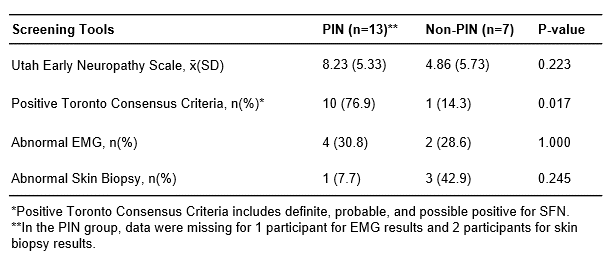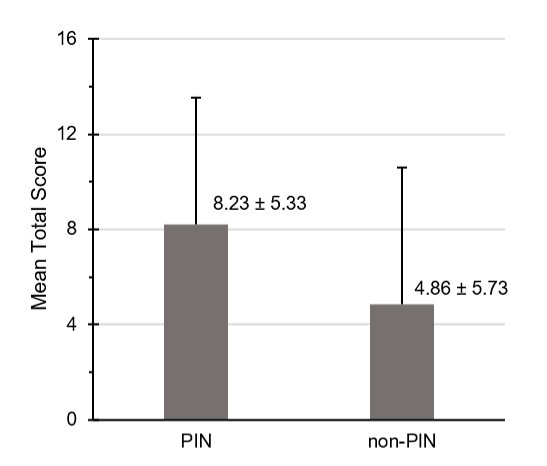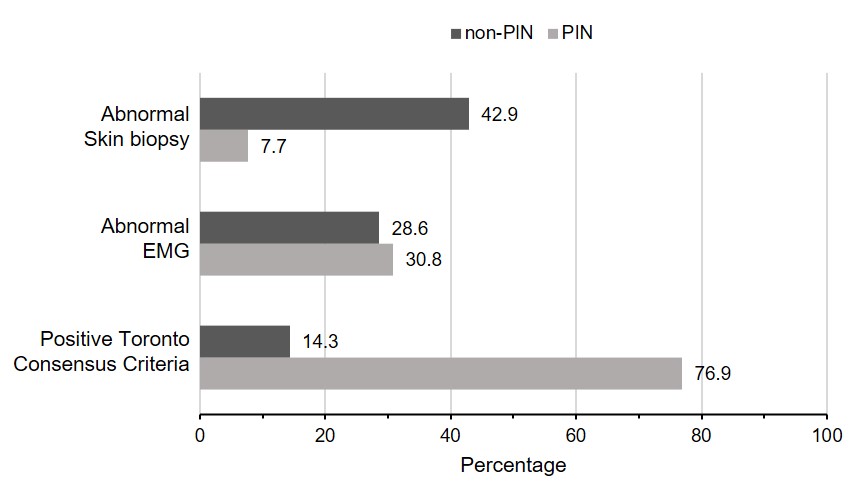Session Information
Session Type: Poster Session A
Session Time: 10:30AM-12:30PM
Background/Purpose: Small fiber neuropathy (SFN) is an underrecognized complication of sarcoidosis which can significantly impair individuals’ physical functioning and quality of life. Diagnosis includes both clinical and histologic testing; however, diagnosis can be difficult in this patient population due to lack of gold standard diagnostic criteria and variable presentations. This study seeks to evaluate potential screening tools and histologic data in the assessment of patients with sarcoidosis-associated SFN.
Methods: This is a cross-sectional study comparing 20 patients with biopsy-confirmed sarcoidosis with and without a physician impression of neuropathy (PIN and non-PIN, respectively). The cohort was evaluated according to the Utah Early Neuropathy Scale (UENS) for small and large fiber sensory and distal motor function on exam, Toronto Consensus Criteria (TCC) for SFN, electromyography (EMG) for large fiber involvement, and skin biopsy for small fiber involvement.
Results: Twenty patients were recruited, ages 30 – 70 years old and 70% female. There were 13 participants with PIN and 7 with non-PIN. Of those with PIN, 76.9% were positive for SFN according to the TCC compared to 14.3% with non-PIN (p=0.02). On the UENS, those with PIN had a higher mean score (mean=8.23, SD=5.33) compared to those with non-PIN (mean=4.86, SD=5.73, p=0.22). With skin biopsy,1 of 11 with PIN had an abnormal skin biopsy compared to 3 of 7 with non-PIN (p=0.25). Finally, 30.8% of participants with PIN had an abnormal EMG compared to 28.6% of those with non-PIN (p=1.00).
Conclusion: Participants with PIN were more likely to test positive for SFN using the TCC and have a higher UENS score, though a statistically significant difference was found only with TCC. By contrast, there was no statistically significant difference in those with PIN or without PIN on EMG and skin biopsy, though these results are almost certainly confounded by small sample size. Although skin biopsy remains the histologic gold standard for SFN, our findings suggest this may be an inadequate diagnostic tool in this condition. We recommend future studies with a larger sample size to evaluate for correlation of UENS scoring and graded TCC classification as potential alternative screening tools for sarcoidosis-associated SFN.
To cite this abstract in AMA style:
Caldwell K, Koppu S, Gwathmey K, Syed A, Kron J, Iden T, Syed H. Investigation of Sarcoidosis-associated Neuropathy: Challenges with Diagnosis of Small Fiber Neuropathy [abstract]. Arthritis Rheumatol. 2024; 76 (suppl 9). https://acrabstracts.org/abstract/investigation-of-sarcoidosis-associated-neuropathy-challenges-with-diagnosis-of-small-fiber-neuropathy/. Accessed .« Back to ACR Convergence 2024
ACR Meeting Abstracts - https://acrabstracts.org/abstract/investigation-of-sarcoidosis-associated-neuropathy-challenges-with-diagnosis-of-small-fiber-neuropathy/



